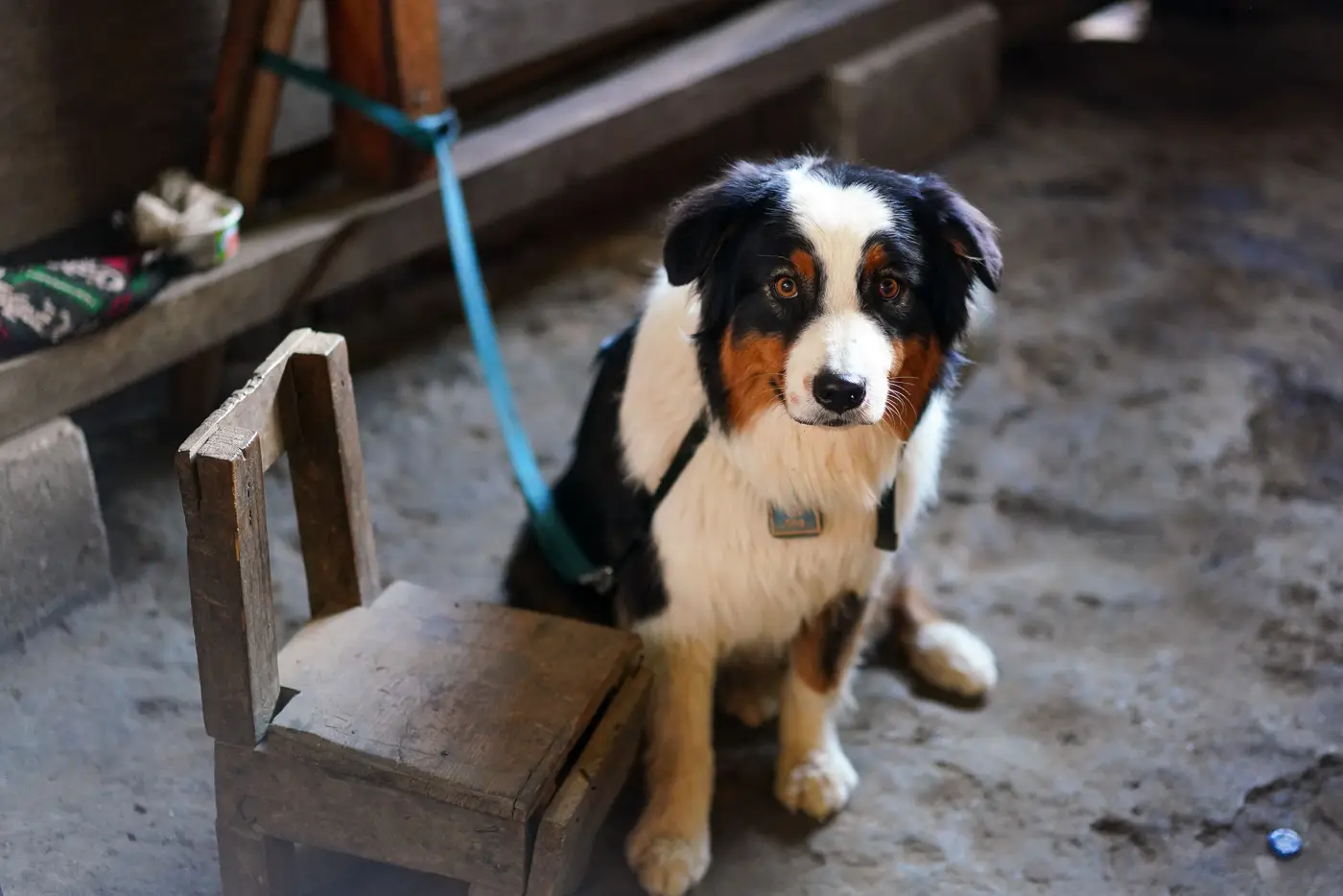Traveling with Pets
Overlanding Skills
Traveling with Pets
Traveling with Pets
Traveling with pets can be both challenging and rewarding.
Preparing for border crossings and flights are logistically difficult. And there will be many things that you won’t be able to do with your pets, including hut trips in Europe, hiking in national parks in the US and exploring Maya ruins in Central America. However, despite these challenges, we have loved traveling with our dog, Oz. Not only is he our furry child, but he’s a constant source of joy and entertainment, as well as a conversation starter and connector with many people in other countries. In this article we focus on overlanding with a dog and cover crossing borders and flying with a dog, as well as, keeping your dog safe.

Overlanding with a Dog
Crossing Borders and Flying with a Dog
Here’s a few tips and tricks regarding crossing borders and taking flights with your dog:
- If you are flying with your dog, make sure that the crate that you are using is approved by the airline and large enough for your dog. Unfortunately, we are not aware of any airlines that rent crates, so you are going to need to buy one (ideally a used one) and sell it when you arrive at your destination and then buy one and sell it again (or keep it for your next overland expedition), when you return.
- Research border crossings ahead of time using the Animal Traveler Facebook Group and iOverlander. Keep in mind that in many countries, including Mexico, Central America and South America, getting the paperwork (essentially import permits) to enter third world countries can be expensive and time consuming. As a result, in many of these countries, we skipped the process, rolled the dice and, in most cases, weren’t asked for the paperwork. However, in other countries like Argentina and Chile, we concluded that we had to follow the process.
- If you are flying with your dog, make sure that the crate that you are using is approved by the airline and large enough for your dog. Unfortunately, we are not aware of any airlines that rent crates, so you are going to need to buy one (ideally a used one) and sell it when you arrive at your destination and then buy one and sell it again (or keep it for your next overland expedition), when you return.
Keeping Your Dog Safe
Some of the biggest health risks when traveling with dogs include abdominal issues, allergic reactions (which often result in respiratory problems), dog bites (or bites from other animals), drowning, heat stroke, hypothermia, paw damage and snake bites. We are not animal health experts, but here are a few tips and tricks to prevent, diagnose, and treat these issues. Most importantly, in the case of an emergency and whenever possible, always seek the help of a trained professional.
Abdominal issues
Check your dog’s stool on a regular basis for rectal bleeding which can be an indicator of abdominal issues. If your dog has a significant amount of blood in his stool on a one time basis, or blood in his stool for more than a day, bring him to a vet right away.
Allergic reactions
Use airway, eye and oral assessments to determine if your dog has been exposed to toxins. To complete an airway assessment, listen and look for discharge from your dog’s nose, coughing that is dry or includes blood or mucus, labored breathing, rapid breathing, shallow breathing and signs of pain when breathing. To complete an eye assessment (which can also help you to determine if your dog has a brain injury), use a flashlight or your hand to see if your dog’s eyes are following the light and are sensitive to the light and evaluate your dog’s pupils, ensuring that they are equal in size and round. To conduct an oral assessment, check your dog’s gums and tongue, ensuring that they are normal. Of course, this requires knowing what your dogs’ gums and tongue typically look and feel like, including their color and moistness. Red gums can be a sign of exposure to toxins and heat stroke. Use Benadryl if your dog is having an allergic reaction, using a dose of 1mg per 1lb, e.g., if your dog is 50lbs, you should give him 50mg of Benadryl.
Cuts
Make sure that your first aid kit includes first aid supplies to treat cuts including cloth tape, homeostatic gauze, e.g., QuickClot (for preventing bleeding) and hydrogen peroxide (for cleaning wounds). We also bring a surgical stapler for us and for Oz.
Dog bites
Street dogs are less problematic than guard dogs, which are trained to attack dogs and humans. We always brought trekking poles with us when we were walking with Oz. Fortunately, we rarely had to use them.
Drowning
Your dog may love to swim, but that doesn’t mean that he can’t drown. Keep your dog away from dangerous water including fast moving rivers, undertows and waves. Use a life jacket like the Ruffwear Float Coat Life Jacket when there is a risk that he could end up in the water.
Foreign bacteria, parasites, and critters (and then some)
Always research the places you are going to for pet-specific and non-pet-specific dangers before taking your pet there. For example, there is a deadly caterpillar called the Pine Processionary Caterpillar in Southern Europe, as well as other parts of Europe that can be lethal to both dogs and children.
Heat stroke and hypothermia
When you are out and about with your dog in the heat, think about whether you would be comfortable if you were wearing his or her coat. If your dog is getting hot, put him in the shade and make sure he drinks lots of water to cool him or her off. Consider using a cooling jacket like the Ruffwear Swamp Cooler Vest. Also consider putting some electrolytes in your dog’s water when it’s really hot like the Petralyte Electrolyte Supplement for Dogs which you can find on Amazon. If you are going to leave your dog in your overland vehicle for extended periods of time, consider buying a Waggle Pet Monitor to monitor the temperature in your vehicle when you are gone. Bring an extra thermometer to take your dog’s rectal temperature. In general, your dog’s temperature should be 101 to 103 degrees. A temperature of greater than 105 and less than 95 is really bad and could indicate heat stroke or hypothermia.
Paw damage
Bring boots like the Ruffwear Grip Trex Dog Boots to protect your dogs paws from hot and sharp surfaces. As a side note, we have found that these booties don’t work well in the snow since the Velcro is too thick and ices up easily, but we use them when we know there may be sharp objects such as rocks and cactus under the snow. As a result, if we are going to be skiing with Oz, we also bring the type of booties that sled dogs used like the MountainRidgeLLC Finish Top Dog Booties that you can find on Etsy. Keep in mind, dogs sweat through their paws and cool off through their paws, so be mindful of temperatures when using them. We had lighter material booties that came in handy when we were on the massive salt flats of the Salar De Uyuni. Make sure that your first aid kit includes tweezers for removing splinters and other objects from your dogs’ body and paws.
Respiratory distress
Check your dog’s heart rate and respiratory rate. Make sure that you know what your dog’s normal heart rate and respiratory rate is. In general, dogs’ heart rates should be 80 – 120 beats per minute and their respiratory rate should be 12 – 30 breaths per minute.
Snake bites
The only thing you can really do to treat your dog for a snake bite is to bring him to a vet that has antivenom. As a result, it’s critical to protect your dog from snake bites. Figure out if there are poisonous snakes where you are traveling and don’t let your dog wander around during the day or at night on his own. When running, have your dog run behind you and ensure he stays on the trail. If your dog does get bitten by a snake, try to figure out what kind of snake bit him, taking a picture of it if possible, remove your dog’s collar and keep an eye out for signs inflammation of get him to a vet as soon as possible, especially if it looks like he was bitten by a venomous snake.
One Final Tip
If you are going to do a lot of long treks with your dog where he or she could get injured, consider bringing an emergency hiking harness like the Mountain Dogware Rescue Harness, so that you can carry the dog back to your rig and get them to a vet.
Almost a Horror Story…
While we were traveling through Northern Argentina, we stopped at a remote informal campsite behind a restaurant and next to a gas station. Let’s just say that it wasn’t glamorous. In the morning, I let Oz out to take a pee and lost sight of him for less than 30 seconds. When I looked over, he was eating from a white plastic bucket that I thought probably contained food for the nearby horses. After getting him under control we hit the remote mountainous road to our next destination. 30-minutes later his entire face was badly swollen. We had no idea whether he had eaten poison, or had been bitten by something like a bee that he was allergic to. We rushed to the nearest vet, 2-hours away, who indicated that she thought he had been bitten by a bee, or insect and gave him a shot, and steroid pills to reduce the swelling. We still have no idea what caused the allergic reaction, but it was one of the most scary and stressful moments on our adventures.
Our Traveling with Pets Resources
Here are a few helpful resources related to traveling with pets:
- The American Kennel Club Owners Manual to Emergency First Aid for Dogs
- Animal Traveler Facebook Group is a great community. Just keep in mind that you might get inconsistent advice from different travelers.
- Dogs Without Borders is an eBook published by Lorraine, who is the admin of the Animal Travelers Facebook Group
- Clifton Slay did a great seminar on backcountry dog 1st aid and emergency care at one of the Overland Expos we attended. I don’t know if he will be doing it again, but you can contact him to see what your options to get the training are.
- iOverlander is an app you can find information on vets, as well as the rules and regulations regarding crossing borders with pets
Comments are closed.






